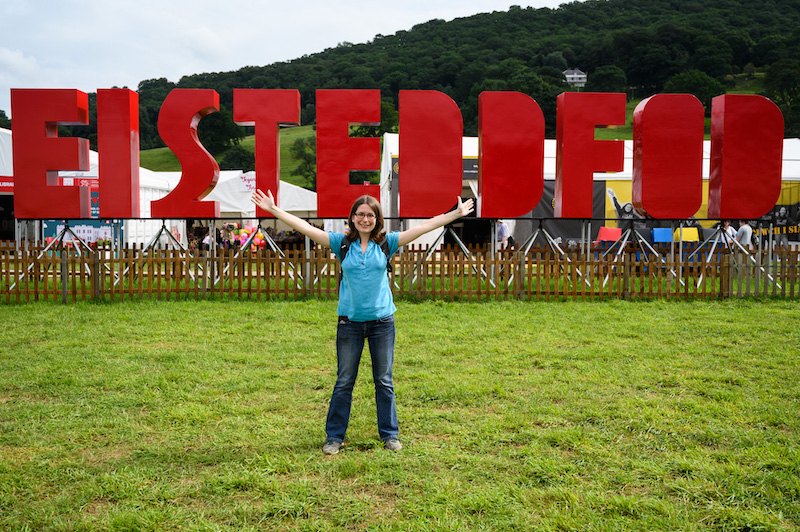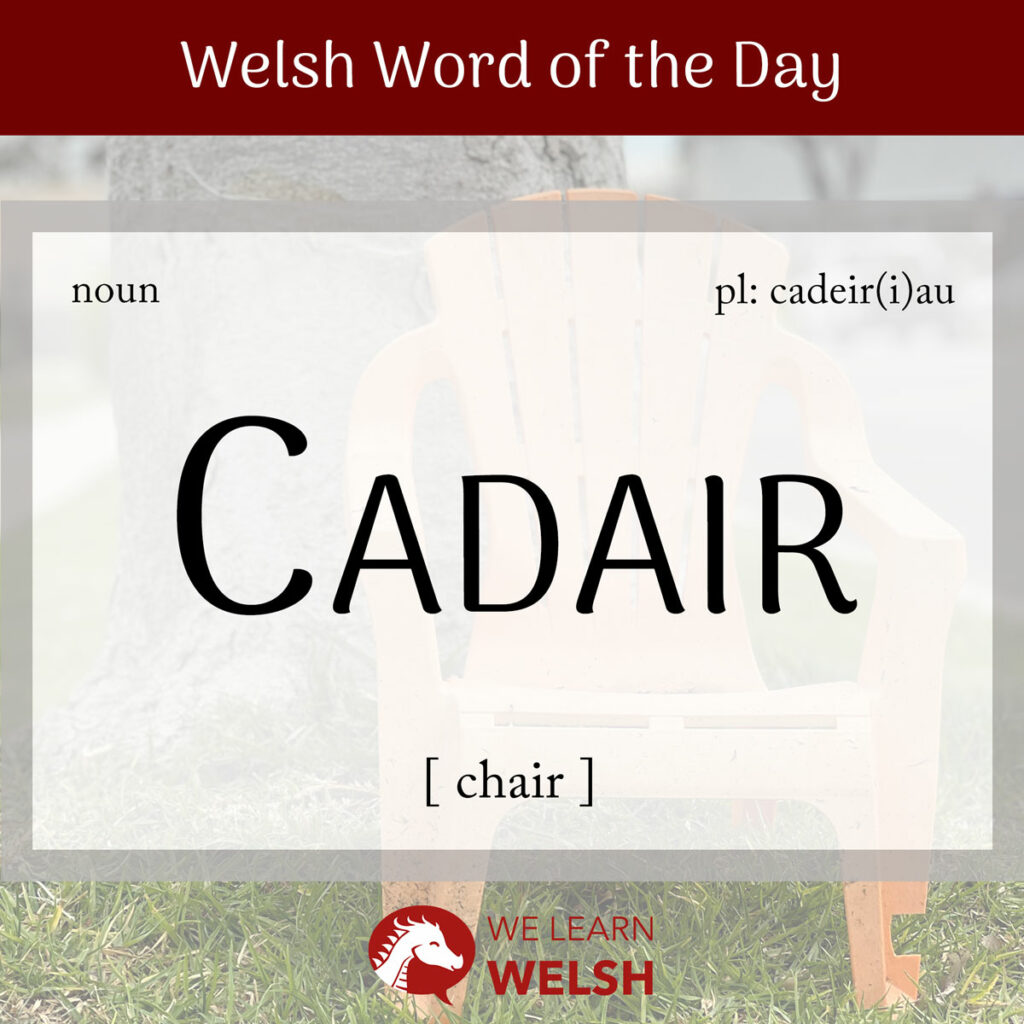From the height of the glorious Cadair Idris (Idris’ Chair) mountain in Gwynedd, to the ceremony of cadeirio’r bardd (chairing the bard) that is the crowning glory of the Eisteddfod, cadeiriau (chairs) occupy a perhaps unexpectedly significant position in Wales’ culture, geography, and history.
So, get yourself settled in a comfortable cadair freichiau (armchair), and let’s get started learning about the word cadair (chair)!
cadair
chair
It was borrowed into proto-Brythonic as kader from the Latin cathedra (which in turn was derived from Greek), also meaning chair, particularly of the ceremonial kind. Cathedra is, of course, the root of the English cathedral church (cadeirlan or eglwys cadeiriol in Welsh), but it’s actually the ancestor of just chair, too.
It makes sense, then, that there are a couple of religious terms based on cadair, such as cadair ddarllen (lectern, literally reading chair) and cadair ymadrodd (pulpit, literally reciting chair). And cadair has a plethora of further meanings – which we’ll get into! – but on a day-to-day basis you’ll most often need to use it to mean chair.
Synonyms include the alternative, colloquial pronunciation cader, and sometimes, in the South, stôl (plural: stolion / stoliau), which was borrowed from Middle English, and is also the standard translation of stool.
Soft mutation
gadair
Nasal mutation
nghadair
Aspirate mutation
chadair
Because cadair is a feminine noun, the soft mutation applies to it very frequently, as this means it mutates after the definite article y (the), becoming y gadair (the chair).
A cadair is a kind of sedd (seat) usually made of pren (wood), metel (metal), or plastig (plastic). Someone who makes cadeiriau pren (wooden chairs) is a saer (carpenter). Many chairs are clustogog (upholstered), which makes them more cyfforddus (comfortable). Cadeiriau have coesau (legs), a sedd (seat), and a cefn (back).
There are a lot of different kinds of cadeiriau, some of which are much nicer to eistedd (sit) on than others. Here are a few of them in Welsh:
- cadair esmwyth = easy chair
- cadair dro = swivel chair
- cadair uchel / cadair plant = highchair
- cadair blygu = folding chair
- cadair glustiog = grandfather chair
- cadair siglo = rocking chair
- cadair olwyn = wheelchair
- cadair ardd = garden chair
- cadair drydan = electric chair
You might sit in a cadair that’s pulled up at the bwrdd (table), you might like a bit of luxury and use a troedfainc (footstool), or you might forgo cadeiriau altogether and choose to curl up on the soffa (sofa) instead.
Rwy’n eistedd ar y gadair.
I’m sitting on the chair.

The weirdest use of cadair, though, has got to be as a translation of udder, as in cadair buwch (a cow’s udder). It’s unclear how this usage evolved, although Geiriadur Prifysgol Cymru (The University of Wales Dictionary) records it beginning in the 17th century. Colloquially, most people are more likely to use pwrs in the North or piw / piwyn in the South.
More familiar to an English speaker will be the use of cadair, like chair, to refer to someone who heads up a meeting or a Board. Specifically, a chairman or chairperson is a cadeirydd. The verb form is cadeirio, so to chair a meeting would be cadeirio cyfarfod. The word llywyddu (preside over) could also be used here. To vacate the chair is gadael y gadair.
Pwy sy’n mynd i gadeirio’r cyfarfod nesaf?
Who’s going to chair the next meeting?
In place names, cadair can refer to one of two things – either a castle (castell) or fort, or a mountain (mynydd) that is thought to be shaped like a cadair. This is true in the case of the mountain Cadair Idris in Gwynedd, one of the most famous peaks of Eryri (Snowdonia). The summit of Cadair Idris is known as Penygader (top of the chair / top of the fort).
Cadair Idris gets its name from the semi-mythical Welsh king Idris ap Wyddno, sometimes known as Idris Gawr (Idris the Giant). We see records of this name being used for the mountain as early as the 1400s, in the poetry of Lewys Glyn Cothi.
There is a common misconception that Idris is a Welsh form of Arthur, and that Cadair Idris was the seat of this other legendary Welsh brenin (king), but there’s no truth to this. Idris, though, was a real historical figure, known for his love of barddoniaeth (poetry) and seryddiaeth (astronomy). He is said to have used the height of Cadair Idris to study the sêr (stars). I’m not so sure about the story that he was so big that he used it as his throne!
This beautiful mynydd is speckled with unique rock formations and small valleys, the remnants of glacial erosion. It’s rumoured that some of the lakes that surround Cadair Idris are bottomless, and the story goes, too, that anyone who spends the night sleeping on Cadair Idris will wake up either gifted with the dawn (wisdom / poetic gift) of Idris himself, or having gone mad.
Mae seiri yn saernïo cadeiriau.
Carpenters make chairs.
You may or may not be aware of the wonderful Welsh tradition of the Eisteddfod, a festival based around competitions in llenyddiaeth (literature) and cerddoriaeth (music). The Eisteddfod has occurred since the 12th century, but was revived in the late 1700s in order to give a boost to the Welsh iaith (language) and diwylliant (culture), which was suffering under Anglicisation.

The two most important events of the Eisteddfod are cadeirio’r bardd (the chairing of the bard) and coroni’r bardd (the crowning of the bard). The Chair and the Crown are highly respected gwobrau (prizes) which are traditionally awarded to the bardd (poet / bard) who produces the best awdl (this is a specific form of Welsh poem written in strict rhyme and meter) and the best pryddest (free verse poem), respectively.
Poems are submitted under a pen name, and the author’s identity is only revealed on their victory. A poem which was good enough to earn either the cadair or the coron may be referred to as a cerdd gadair (chair poem). However, nowadays, the coron (crown) is sometimes instead awarded to the best prose writer, who would traditionally be given a medal.
You might hear the cadair of the Eisteddfod referred to as the cadair eisteddfodol or the cadair farddol (bardic chair). A new cadair farddol is designed and constructed for each Eisteddfod, and can even be withheld if none of the entries are considered good enough to win.
The cadair is awarded in an iconic ceremony administered by the Archdderwydd (Archdruid), presiding official of the Eisteddfod. The Archdderwydd holds a ceremonial sword above the winner’s head and asks the audience, A oes heddwch? (Is there peace?)
The affirmative answer Heddwch! (Peace!) from the audience, repeated three times, gives the Archdderwydd permission to officially grant the bardd their victory. They are then honoured with a traditional dance performed by local children.
Mae hi wedi ennill y Gadair yn yr Eisteddfod.
She has won the Chair at the Eisteddfod.
The ennill (winning) of either cadair or coron is a huge honour which earns the ysgrifennwr (writer) the title of Y Prifardd (The Chief Bard). Prifardd can be used either as a common noun, or as an honorific title – for example, Y Prifardd Mererid Hopwood. It is fairly common for previous prifeirdd (chief bards) to later go on to achieve the rank of Archdderwydd, as indeed Mererid Hopwood has since done.
The winner of y Gadair at the 2024 Eisteddfod was Carwyn Eckley.
On one occasion, y Gadair was awarded posthumously. This was in the case of Hedd Wyn (Blessed Peace), the pen name of the incredible poet Ellis Humphrey Evans, who won the honour of Prifardd for his poem Yr Arwr (The Hero), a four-part pacifist ode, at the 1917 Eisteddfod.
Ellis was killed in the Battle of Ypres in the First World War, which was only discovered after his victory was announced at the crowning ceremony. Y Gadair was delivered to Ellis’ parents covered in a black cloth, and the 1917 Eisteddfod has since been known as Eisteddfod y Gadair Ddu (The Eisteddfod of the Black Chair). It’s a tragedy that has shaped Welsh history.
Have you attended an Eisteddfod in the past? Or would you ever try your hand at writing some barddoniaeth Cymraeg (Welsh poetry) of your own?

